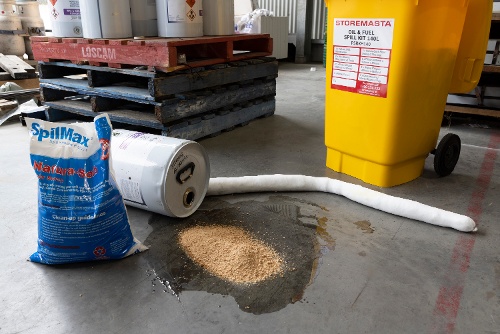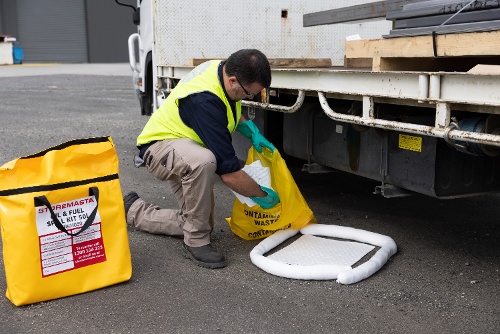Positioning
- We recommend placing a spill kit within 30 metres of any possible threat, including areas where hazardous substances are stored and dispensed. Spill kits should also be carried in work vehicles where there is a risk of a chemical leak or spill.
- Position your spill kit in a static location, so that staff always know where the spill kit is. The location should be well-lit, accessible and visible – properly placarded with signage that states SPILL KIT or a similar reference.
IMPORTANT: Section 357 of the Model Work Health and Safety (WHS) Regulations states that your spill containment system must provide for the cleanup and disposal of hazardous chemical leaks, spills and resulting effluent.
Using the Kit
There are some general steps that you can take to cleanup your spill. Your Storemasta spill kit will come complete with a general instruction card, although we highly recommend formal spill kit training for your nominated Spill Response Team. This will help them increase safety and efficiency when dealing with a leak or spill.
We also recommend conducting a chemical risk assessment at your site, so that all hazards in your workplace are identified and controlled in the event of an accidental release of chemicals.
Steps to managing a chemical leak or spill:
- Staff must cordon off the area and notify the Spill Response Team.
- The Spill Response Team (who will put on appropriate PPE) will attend the site.
- Assess the risk, including the hazards associated with the chemical and those in the area.
- Get the correct spill kit suitable for that particular spill (type of kit, quantity).
- Stop and contain the spill with booms, absorbent pillows or suitable items.
- Absorb the chemical spillage.
- Cleanup the site and decontaminate.
- Dispose of chemicals and waste in the bags marked ‘contaminated waste’. Ensure you’re disposing of your waste in the appropriate manner by consulting with your local waste authority.
- Report the incident and take corrective action.
- Inspect and replenish the spill kits.
Inspecting the Spill Kit
To ensure that your spill kit is replenished and in good working order, it’s important that regular inspections are conducted.
- Your spill kit inspection list should mirror the contents of each kit.
- Keep an updated list of contents on the front of your spill kit, so you can make sure that each kit is effectively stocked.
- Nominate a day, time and staff member to conduct the inspections.
- Ensure that stock is available onsite to immediately replenish the kit if it is deemed necessary by the inspection.
- Look out for missing items, as well as old, damaged, soiled or otherwise unusable items.
Get Your FREE Spill Kit Inspection Checklist
REMEMBER: There are various types of spill kits for certain chemicals, quantities and situations. Storemasta spill kits include Chemical Spill Kits, Marine Spill Kits, Oil & Fuel Kits and Universal Spill Kits. Some chemicals may not be suitable for some materials, so check with our team for information on chemical compatibility with our absorbent items.
Maintaining the Spill Kit
Your spill kit will contain a range of items to help you manage the containment, cleanup and disposal of your chemical spill. All kits come with a contents sheet for ease of ordering.
These items may include (but not limited to):
- Floor sweep
- Spill absorbents
- Spill mat
- Waste bags & ties
- Gloves and other PPE items
- Wheelie bin

In addition to these standard spill kit items, you will also have to provision for:
- Personal protective equipment suitable for the chemical product (refer to your SDS).
- Cleanup equipment, such as shovels and brooms.
- Spare chemically compatible containers with labels for chemicals in split packages.
- Substances suitable for the decontamination of the area.
- Neutralisers (if you’re working with acids or alkalis – refer to your SDS).
REMEMBER: Individual items, such as absorbents, and spill kit refill kits are all available directly from Storemasta.
Expiry Dates
- Some items in your spill kit may have an expiry date on them. Always check the expiry date and replace your items when required. Generally speaking, polypropylene spill kit items may expire around 1 – 2 years, while floor sweeps have a longer shelf life if they are kept dry.
- Look for signs of expiration, such as powdery material on polypropylene pads or absorbents that have a shattered surface.
IMPORTANT: If any items in your kit aren’t in perfect working order, you need to replace these so your spill kit is effective the next time it is used.
Download Product Manual PDF
Get in touch:
Would you like some further advice on spill containment and cleanup — or spill prevention controls, such as bunding? Simply send your enquiries to our helpful team at sales@storemasta.com.au or call on 1300 134 223.
Further resources:
See some of our recent spill kit blogs to learn more about our solutions.
Joining the team as a Dangerous Goods Storage Consultant, Melissa Hampton became Storemasta's Marketing Manager in late 2021. With extensive knowlege and experience in chemical compliance, Melissa is responsible for leading the Marketing team and helping shape their marketing strategy. In her spare time, you can find Melissa hiking, swimming and enjoying the great outdoors in beautiful north-west Tasmania.
